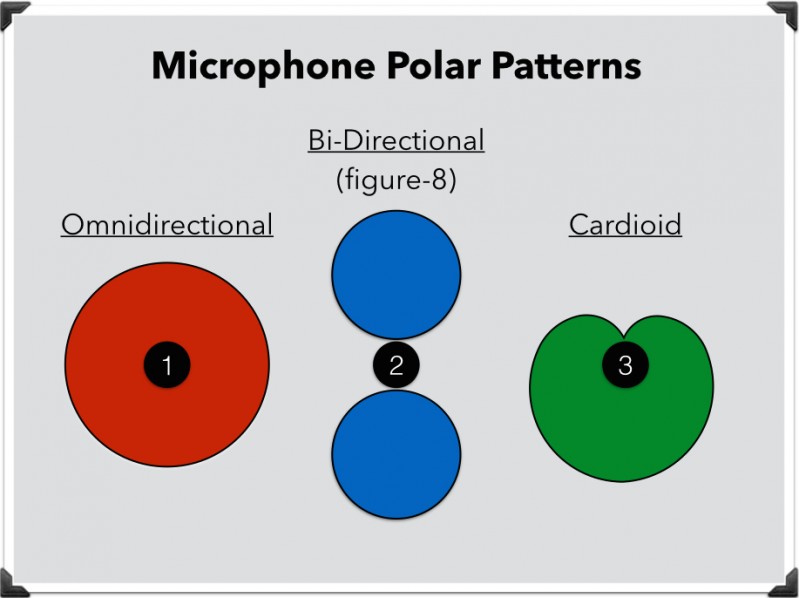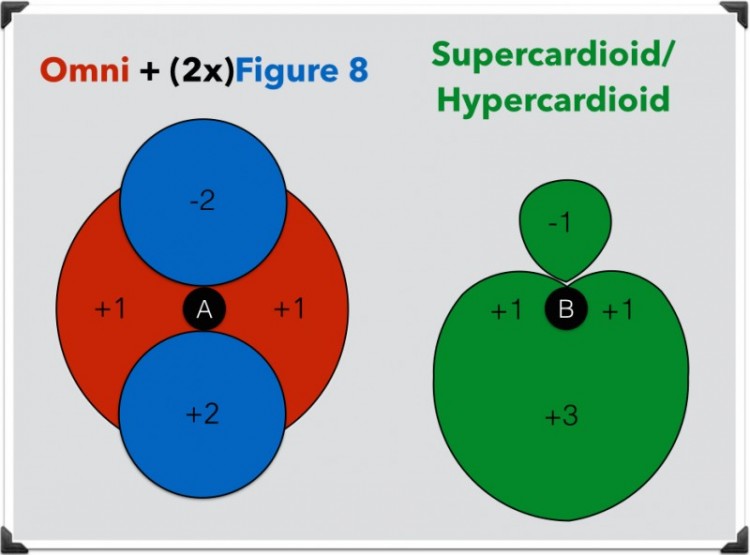
When it comes to microphone polar patterns, you’ve most likely heard the following 3 terms a million times:
Cardioid, Omnidirectional, and Figure-8.
But what do they actually MEAN?
And why are they SO important when choosing the right mic?
If you’ve got questions, and you want answers…
Then here’s what I have for you:
In this post, I’ve assembled this easy-to-read guide entitled…A Beginner’s Introduction to Microphone Polar Patterns.
A Quick Definition of Microphone Polar Patterns
A microphone’s polar pattern is the 3-dimensional space surrounding the capsule where it is MOST sensitive to sound.
The 3 basic patterns are:
- omnidirectional
- figure-8
- cardioid
Here’s a diagram showing how they look:

As you can see…
- Mic 1 has an omnidirectional pattern – meaning the entire red area is equally sensitive to sound.
- Mic 2 has a figure-8 pattern – meaning the two blue areas on the front and back are sensitive, while the sides are ignored.
- Mic 3 has a cardioid pattern – meaning the green area in front of the mic is most sensitive, the sides are less sensitive, and the rear is ignored.
Common Microphone Polar Pattern Variations
Other than the 3 basic patterns, you also see:
- Supercardioid – which is like cardioid, but NARROWER, with a small bulb of rear sensitivity.
- Hypercardioid – which is like supercardioid, but narrow still, and with a larger bulb in the rear.
Some mics, known as “multi-pattern mics” allow you to switch between several polar pattern options as needed.
Now here’s where all this technology came from…
How These Polar Patterns Came to Be
In the earliest days of microphone technology, there were only 2 polar patterns:
- Omnidirectional
- Figure-8
Omnidirectional Mics
Originally known as “pressure” microphones, their diaphragms measured sound pressure at a single point in space.
Because they had no directional information, they were equally sensitive to sound from all directions.
Figure-8 Mics
Commonly known as “pressure gradient” microphones, they measured the DIFFERENCE in pressure between either side of an open diaphragm.
This meant that they were very sensitive to sound from the front and rear, but almost completely deaf on the sides.
The Birth of Cardioid Mics
Eventually someone discovered that by combining the signals of BOTH omnidirectional AND figure-8 mics…
Here’s what happens:
- In the front – the positive signals combine to be 2x as strong.
- On the sides – the signal from the omni remains the same.
- In the rear – the negative signal of the figure-8 cancel out the positive signal of the omni.
The result became what we know today as a standard cardioid polar pattern.
Here’s a diagram to illustrate it:

Eventually engineers designed new cardioid capsules that were essentially hybrids of the original two designs. Soon afterward, came these next patterns:
Supercardioid/Hypercardioid
The next major advancement came when someone realized that cardioid patterns could be made even MORE directional by mixing MORE figure-8 signal with LESS omni.
As a side effect, this would also create a small bulb of sensitivity emerging from the rear.
This new pattern became known as supercardioid, and the narrower version known as hypercardioid.
In this example diagram, I show how it works by combining 1 part omni with 2 parts figure-8:

Now let’s move on…
How Multi-Pattern Mics Work
Rather than requiring a separate mic for every job…engineers came up with an ingenious idea to cram a TON of versatility into just one mic.
They realized that…simply by varying the output from two back-to-back cardioid capsules, you could recreate virtually any polar pattern imaginable.
For example:
- By combining both cardioid signals, you get an omnidirectional pattern.
- By combining both but reversing the polarity of one, you get a figure 8 pattern.
- By turning off one, and using the other, you get a cardioid pattern.
And that’s how we eventually got the multi-pattern mics we use today.
The most famous example of this type of mic? A USB mic known as the Blue Yeti – (Amazon). Check it out.
Next up, let’s see how all these patterns are used to actually record stuff…
When to Use Cardioids
The advantage of using cardioid mics seems simple, right? It records where you point it, and ignores everything else. Which is why it is the obvious choice for vocal mics.
But here are some less-obvious examples when it’s ESPECIALLY useful:
- Miking up a drum kit – With so many instruments so close together, isolation might seem impossible. But it CAN be done, with the right cardioid mics, positioned in the right spots.
- Live performances – On-stage, when sounds are coming at you from all directions, cardioid mics are great maintaining isolation and preventing feedback.
- Untreated rooms – In rooms with poor acoustics, close-miking with cardioid mics can work wonders at minimizing reflected sound.
Now they might seem ideal in most cases..but cardioid mics DO have drawbacks…
The two BIGGEST ones being:
- Off-axis coloration – With most cardioid mics, you see a drop in high frequency sensitivity as sounds move further off-axis. This could be bad, for instance, with an inexperienced singer unconscious of his head movements.
- Proximity effect – A phenomenon exclusive to cardioid mics…proximity effect is a boost in bass frequencies that results from extreme close-miking. Using the same “inexperienced singer” example, you can see how this might also cause problems.
Supercardioid and hypercardioid patterns, while essential for filmmakers, are not commonly used in the recording studio.
When to Use Omni’s
Because they are SO prone to off-axis spill…Omnidirectional mics aren’t nearly as popular as they were prior to the invention of the cardioid pattern.
But by no means does that make them irrelevant. For example…
Here are common situations when they’re preferable:
- When recording the sound of the room – such as with room mics for drums.
- When recording a wide sound source – such as an orchestra, choir, or grand piano.
- When recording a moving target – such as an acoustic guitar player who can’t sit still.
- When recording in stereo – such as with the common A/B technique.
Compared to cardioid mics, omnidirectional mics offer the following advantages:
- immunity to proximity effect
- lower self noise
- a frequency range that typically extends a full octave lower
- less coloration of off-axis sounds
This last advantage is especially true with small diaphragm omni mics. That is why most precise measurement microphones (like Earthworks mics for example) are small diaphragm omni’s.
When to Use Figure-8
So why EXACTLY would you want a mic that was equally sensitive on both sides? It doesn’t seem very useful, does it?
The cliche example you always hear is…to record a duet of singers facing each other.
While it might be great in that situation…how often does that it happen? Almost never.
It’s much more common to use figure-8 mics for one of the following 3 reasons:
- for stereo recording
- with ribbon mics
- for maximum isolation of off-axis sounds
For stereo recording, figure-8 mics are required to perform both the Blumlein Pair, and Mid/Side stereo techniques.
With ribbon mics, the physical make up of the design often requires a figure-8 polar pattern. If you like ribbon mics for their sound, the figure-8 pattern simply comes as part of the package.
To isolate instruments in close proximity, figure-8 mics are ideal because they completely reject sound from the sides.
With smart positioning, you can achieve more isolation with a figure-8 mic than with any other polar pattern. One common trick is to place acoustic absorption at the rear end of the mic to block out any unwanted noises.
Putting Your New Knowledge Into Practice
So now that you know all the basics of microphone polar patterns, it’s time to put this knowledge into practice.
While all these facts may be simple enough in theory…the only way to really get a feel for microphone polar patterns is to experiment.
Take some time to record different instruments, with different polar patterns, in different rooms…and listen to the differences in each combination.
Eventually you get a feel for what works and what doesn’t.
By the way, if you found this post useful, I highly recommend joining our free Home Recording Secrets email newsletter where you’ll discover….
- How to Get Your First Studio Up and Running in a Single Weekend
- How to Avoid Wasting Thousands of Dollars on Unnecessary Pointless Purchases
- How to Get a “Million Dollar” Pro Studio Sound in a “Thousand Dollar” Home Studio
- PLUS… All Sorts of Other Amazing Insider Secrets Revealed
And it’s totally FREE! Click here and Enter Your Email to Sign Up.